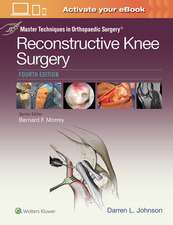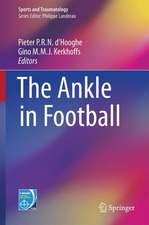The Many Faces of Osteoarthritis
Editat de Vincent C. Hascall, Klaus E. Kuettneren Limba Engleză Paperback – 13 oct 2012
| Toate formatele și edițiile | Preț | Express |
|---|---|---|
| Paperback (1) | 1107.58 lei 6-8 săpt. | |
| Birkhäuser Basel – 13 oct 2012 | 1107.58 lei 6-8 săpt. | |
| Hardback (1) | 1120.19 lei 6-8 săpt. | |
| Birkhäuser Basel – 21 noi 2002 | 1120.19 lei 6-8 săpt. |
Preț: 1107.58 lei
Preț vechi: 1165.88 lei
-5% Nou
Puncte Express: 1661
Preț estimativ în valută:
211.96€ • 218.97$ • 176.41£
211.96€ • 218.97$ • 176.41£
Carte tipărită la comandă
Livrare economică 26 martie-09 aprilie
Preluare comenzi: 021 569.72.76
Specificații
ISBN-13: 9783034894500
ISBN-10: 3034894503
Pagini: 540
Ilustrații: XL, 495 p.
Dimensiuni: 155 x 235 x 28 mm
Greutate: 0.75 kg
Ediția:Softcover reprint of the original 1st ed. 2002
Editura: Birkhäuser Basel
Colecția Birkhäuser
Locul publicării:Basel, Switzerland
ISBN-10: 3034894503
Pagini: 540
Ilustrații: XL, 495 p.
Dimensiuni: 155 x 235 x 28 mm
Greutate: 0.75 kg
Ediția:Softcover reprint of the original 1st ed. 2002
Editura: Birkhäuser Basel
Colecția Birkhäuser
Locul publicării:Basel, Switzerland
Public țintă
ResearchCuprins
Type IIA procollagen NH2-propeptide functions as an antagonist of bone morphogenetic proteins.- Genetics and osteoarthritis.- Metabolic differences between knee and ankle.- Prevention of lower limb osteoarthritis: Data from The Johns Hopkins Precursors Study.- The inheritance of hip osteoarthritis in Iceland.- Dynamics of matrix loss in the spontaneous osteoarthritic mouse stran STR-1N.- Identification and characterization of human cell populations capable of forming stable hyaline cartilage in vivo.- Osteogenic protein-1 promotes proteoglycan synthesis and inhibits cartilage degeneration mediated by fibronectin-fragments.- Osteogenic protein-1 and its receptors in human articular cartilage.- Behringer The transcription factors L-SoxS and Sox6 are essential for cartilage formation.- Amelogenin peptides have unique milieu-dependent roles in morphogenic path determination.- Electron microscope studies of collagen fibril formation in cornea, skin and tendon: Implications for collagen fibril assembly and structure in other tissues.- Hyaluronics and aggrecanics.- Lectin domains in hyaluronan-binding proteoglycans.- The matrilins: A novel family of extracellular adaptor proteins.- Superficial zone protein (SZP) is an abundant glycoprotein in humansynovial fluid with lubricating properties.- Establishment of in vitro cell culture models for the investigation of the pathogenesis of cartilage diseases.- Role of hyaluronan in regulating joint fluid flow.- Elastoviscous hyaluronan in the synovium in health and disease.- The covalent complex formation of hyaluronan with heavy chains ofinter-a-trypsin inhibitor family is important for its functions.- Spicer In vivo investigation of hyaluronan and hyaluronan synthase-2 function during cartilage and joint development.- CD44 and cartilage matrix stabilization.- Metalloproteinases and osteoarthritis.- Age-dependent changes in some physico-chemical properties of human articular cartilage.- The role of the bone/cartilage interface in osteoarthritis.- Dualistic role of TG Fß in osteoarthritis cartilage destruction and osteophyte formation.- Collagen cross-links as markers of bone and cartilage degradation.- Markers of joint tissue turnover in osteoarthritis.- Gene expression profiling by the cDNA array technology: Molecular portraying of chondrocytes.- Clinical evaluation of markers for osteoarthritis.- Joint degradation in rapidly destructive and hypertrophic osteoarthritis of the hip.- Differential gene trap: A new strategy for identifying genes regulated during cartilage differentiation.- Imaging cartilage changes in osteoarthritis.- Diffraction enhanced x-ray imaging of articular cartilage.- Bone changes in osteoarthritis.- Radiographic joint space width (JSW): A marker of disease progression in osteoarthritis of the hip.- Small proteoglycans in knee and ankle cartilage.- Fixed charge density and cartilage biomechanics.- Influence of tissue shear deformation on chondrocyte biosynthesis and matrix nano-electromechanics.- The biomechanical faces of articular cartilage in growth, aging, and osteoarthritis.- Cartilage tissue engineering using a new self-assembling peptide gel scaffold..- Differential effects of IL-1 ß on human knee and ankle chondrocytes.- Dynamic function and imaging in the analysis of osteoarthritis at the knee.- Linking the biology of osteoarthritis to locomotion mechanics.- Movement patterns of individuals with good potential to dynamically stabilize their knees after acute ACL rupture.- Neuromuscular control of the ACL deficient knee: Implications for the development ofosteoarthritis.
Textul de pe ultima copertă
Osteoarthritis is the most common joint pathology which primarily affects the older population. The disease is characterized by unique pathological changes in some synovial joints, predominantly affecting the articular cartilage, but also entire joints, including the synovial tissue and subchondral bone.
The remarkable growth of research on normal and abnormal biology of tissues in the articulating joint, including the application of novel molecular biological approaches and new imaging techniques, is reflected in this volume. It describes the current state of knowledge and helps to further understand the etiopathology of osteoarthritis, hopefully leading to early detection of the disease and novel treatment modalities. The volume contains contributions and discussions from a select group of investigators, all experts in this field, who met at the conference "The Many Faces of Osteoarthritis", held in June 2001 at Lake Tahoe, to acknowledge Klaus E. Kuettner and his contributions to osteoarthritis research.
The book is a valuable source of information for researchers as well as for clinicians working in the fields of bone and joint surgery, tissue engineering, orthopaedics, rheumatology, and biomedicine.
The remarkable growth of research on normal and abnormal biology of tissues in the articulating joint, including the application of novel molecular biological approaches and new imaging techniques, is reflected in this volume. It describes the current state of knowledge and helps to further understand the etiopathology of osteoarthritis, hopefully leading to early detection of the disease and novel treatment modalities. The volume contains contributions and discussions from a select group of investigators, all experts in this field, who met at the conference "The Many Faces of Osteoarthritis", held in June 2001 at Lake Tahoe, to acknowledge Klaus E. Kuettner and his contributions to osteoarthritis research.
The book is a valuable source of information for researchers as well as for clinicians working in the fields of bone and joint surgery, tissue engineering, orthopaedics, rheumatology, and biomedicine.










